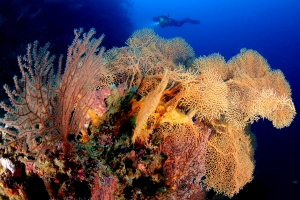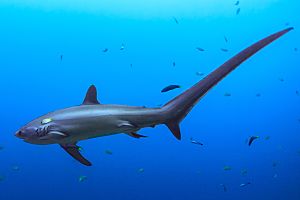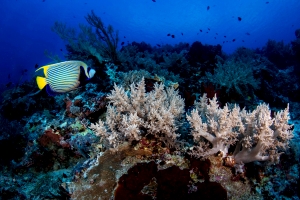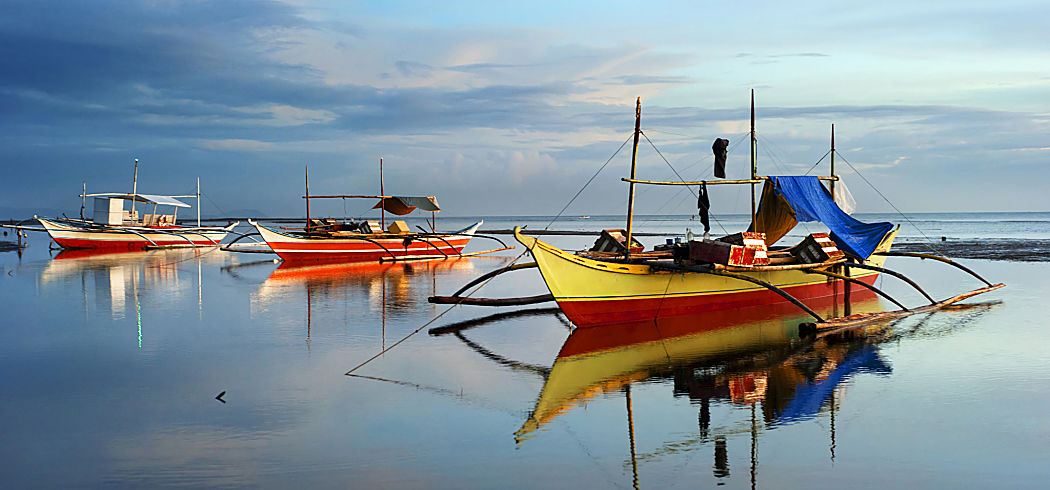 Walls & drift dives, “muck” & “critters”, macro & wide-angle photos (including plenty of shark shots). Immense bio-diversity makes this destination alluring for all serious divers.
Walls & drift dives, “muck” & “critters”, macro & wide-angle photos (including plenty of shark shots). Immense bio-diversity makes this destination alluring for all serious divers.
SCUBA HIGHLIGHTS
Pervasive HARD & SOFT CORALS in a MYRIAD OF COLORS meet the eye. Also, elegant gorgonian fans & massive sponges … MAGNIFICENT WALLS, sheer drop-offs & SOME WILD CURRENTS. The CRAZY MACRO CRITTERS (pygmy seahorses, frogfish, ornate ghost pipe fish, waspfish, blue-ringed octopus) captivate certain photographers … while others can’t resist the allure of BOUNTIFUL SCHOOLS of jacks, barracudas, snappers & Napoleon wrasse. Reef sharks, leopard sharks, guitar sharks, THRESHER SHARKS & hammerheads all spin their magic while WHALE SHARKS, MANTAS & EAGLE RAYS and a multitude of WWII WRECKS add the crowning touches.
A MYRIAD OF CORALS & CRITTERS
The Philippines is known to divers for hard and soft corals in a rainbow of colors, plus elegant fans and massive sponges; for marine diversity that, in many places, equals that of Indonesia; and for magnificent walls and sheer drop-offs.
Due to the variety of dive sites you’re likely to encounter everything from mantas & whale sharks to pygmy seahorses & that ever elusive blue-ringed octopus.
You’ll see schooling anthias & fusiliers in amazing numbers. You’ll find ghost pipefish galore, plus lion and scorpion fish, crabs and shrimps, razor fish, cushion stars, frogfish, leaf fish, Oriental sweetlips, batfish, mandarin fish and puffer fish.
BLUE-WATER WONDERS, TOO
In contrast, some dives will take you to deeper waters where you’ll have wide-angle shots of manta rays, nurse sharks, guitar sharks, and numerous other shark species, including the always intriguing hammerheads. You’ll encounter snappers, turtles, surgeon fish, schooling Trevallies and jacks. And, that’s the tip of the iceberg.
As a plus for wreck fans, the waters around Palawan are host to a variety of movingly beautiful World War II wreck sites.

VAST OPPORTUNITIES …. TOUGH CHOICES
The Philippines nation consists of 3 major regions …. Luzon, Visayas and Mindinao …. and for divers, the greatest concentration of interesting sites lies in the Visayas region … which is central Philippines …. although Luzon (the island on which the capital, Manila is located) also boasts some great diving and one of our favorite dive resorts is situated not too far from Manila itself.
Mindinao, the Philippines southernmost region, continues to be plagued by political struggles and while the diving is certainly as magnificent as in other regions, the risk to travelers and the lack of infrastructure take it off our radar for the moment.
Many of the Visayas sites are accessible exclusively by liveaboard …. and there’s no single cruise, whether 7, 10 or 14 days, which can take you everywhere in this vast region.
Lots of the great dive sites are relatively close to one another, while some are great distances apart. Add to that the fact that even within the region, the diving varies based on weather patterns and animal migratory habits. So …….the liveaboards combine diving areas creatively to offer you different itineraries.
While part of that packaging is weather-related, a part is born of the desire to ensure dive-site variety and ample excitement for divers. A final aspect, of course, is avoiding overcrowding at the most popular sites.
UNWIND DURING AN ISLAND STAY
But, topside too, the scenery is spectacular. The lushness of the islands, the sweeping beaches, the plunging waterfalls and the contrasting hues of the seas all add to the ambiance of your visit. As to the resorts, diving is year-round and excellent !
PHILIPPINES DIVING … A SMORGASBORD OF CHOICES
{slider  Puerto Galera / Anilao / Batangas … pot pourri of diving … just about everything
Puerto Galera / Anilao / Batangas … pot pourri of diving … just about everything
Puerto Galera is one of those opportunities for everything from the minute to the massive …. but with an accent on macro creatures & muck … featuring frogfish, ghost pipefish, scorpionfish, lizardfish and countless varieties of nudibranchs. Not far from Manila, it is easy to access great diving here. In addition to the creature world, you have the usual Philippine contingent of colorful coral gardens. For experienced divers, a few of the sites in this area add a nice bit of drama to the package. You can find currents and canyons and walls, some great drift dives and plentiful jacks, barracudas, snapper and sweetlips …. plus passing whitetip and blacktip reef sharks … read more …|dest|closed}
Very near to Puerto Galera is Anilao, a Marine Protected Sanctuary. The diving here is also at both ends of the diving spectrum, with great critter life (spectacular macro photography) and some nice currents which bring in big fish and sharks. The muck diving is regarded as some of the finest in the world, in contention with Lembeh Strait in Indonesia. Rhinopias, mantis shrimp, mimic octopus and blue-ringed octopus are just a few of the attractions which await you. At the other end of the scale are jacks, trevallies, barracudas and plenty of reef sharks. Corals here are also plentiful and healthy.
{/sliders} {slider  Apo Reef… lovely corals & critters … but mainly known as a pelagic destination
Apo Reef… lovely corals & critters … but mainly known as a pelagic destination
Apo Reef is often considered one of the premier diving destinations in the Philippines and best known as a pelagics destination (sharks & huge schools of fish) although it is graced with a superb sea-fan covered wall which is filled with prolific marine life. This Marine Sanctuary (also a UNESCO world heritage site) contains the largest atoll in the Philippines, along with an impressive reef system, the second largest in this island nation. … read more …|dest|closed}
In addition to the critters in the corals, you find fusilleers, surgeonfish and triggerfish, you get snapper, tuna, groupers, jacks, plus manta rays, white tip sharks, gray reef sharks … not to mention spinner dolphins and frequent passing whales.
{/sliders} {slider  Borocay … walls, corals, sharks
Borocay … walls, corals, sharks
There are multitudes of dive sites but probably the most popular amongst experienced divers is Yapak …. known for its sheer walls, enveloped with an extraordinary diversity of coral species, plunging from 30 meters (100 feet) to at least 70 meters (230 feet). The wall has plenty of exciting visitors also – whitetip, blacktip and grey reef sharks, dogtooth tuna, barracuda, groupers, napoleon wrasses and giant trevallies … as well as mantas and eventhe occasional hammerhead… read more …|dest|closed}
Please note, conditions can be challenging. This is not for novice divers. The rest of the diving in the area provides plentiful colorful corals and active reef life and some excellent macro-life sites.
{/sliders} {slider  Coron … WWII wrecks
Coron … WWII wrecks
For wreck-diving aficionados, Coron is considered one of the world’s top destinations. 24 Japanese vessels went down here during an American attack in 1944 and roughly half have been found, most of which lie at recreational diving depths. The vast majority of the sunken ships are lying in waters from 12 – 30 meters /40 – 100 feet deep – so are easily do-able for the average diver. Do note, however, that conditions can be challenging, so make sure your dive master knows your qualifications & experience. … read more …|dest|closed}
Also, while the ships are in exceptionally good condition and make for compelling diving for history & wreck buffs, be aware that normally there’s pretty low viz and marine life is not as extenensive as you’ll see in other areas of the Philippines. Coron is for those who are passionate about and intrigued by the distinct beauty of this vanquished fleet and its historical significance.
{/sliders} {slider  Malapascua … critters & sharks, especially the elusive thresher sharks
Malapascua … critters & sharks, especially the elusive thresher sharks
This area has become particularly popular due to the ease of viewing thresher sharks – many up to 6 meters (nearly 20 feet). For a little added thrill, you often see manta rays in the same area. A deep-water shark, the threshers surface early for cleaning so your liveaboard will get you up and out early for the excitement. Their sinewy bodies are a sight like no other … read more …|dest|closed}
And, surprisingly, this site which is known for its grand pelagics, is surrounded by diving sites which house some of the best of the critter world (seahorses, flamboyant cuttlefish, pipefish, mandarin fish, ornate ghost pipefish, some wild & wonderful frogfish, even blue-ringed octopus) …. and lots of fish (lionfish, Moorish idols, schooling bannerfish, unicorn fish) … plus squid, octopus, morays and shrimp …. along with turtles, tuna and barracudas.
Nearby Gato Island is home to nurse sharks, whitetip reef sharks and the rare bamboo shark, while Kimud Shoal is known for sightings of schooling hammerheads from December to April. At Donsol, whaleshark sightings are the claim to fame. This site, usually visited at one end of a Malapascua itinerary, also has a great pass for manta encounters, Ticao Pass. December to May is the ideal season.
Ticao, known as “Manta Bowl”, is the place for gentle giants which are drawn by the plankton bloom from the San Bernadino Pass. Thresher sharks and the occasional hammerhead have also been spotted here.
{/sliders} {slider  Cebu … corals & critters
Cebu … corals & critters
The area which is often referred to as Cebu (many of the liveaboards leave from Cebu City for certain itineraries) is largely about corals (filled with pygmy seahorses and frogfish), sponges and reef fish …. with a smattering of pelagic dives and walls thrown into the mix. Mactan Island is popular in large part due to the numerous whale shark encounters which it affords. But, you also find some nice walls & steep reefs with soft corals, sponges & black corals plus the critter-dive hot spot at Padre Burgos Pier, where seahorses, frogfish, pipefish and mandarin fish can all be seen. … read more …|dest|closed}
Moalboal has a number of sites, not the most challenging of Phillipines regions, but lovely diving, Generally known as being great for novice and less experienced divers. The top site in this area is probably Pescador Island, with its more interesting underwater geography, including superb walls, overhangs, drop-offs plus its abundant soft corals and fish life.
Also, around Moalboal & Pescador Islands are sardines schools which attract the occasional thresher shark and whale sharks are frequently seen in the channel.
{/sliders} {slider  Leyte … reefs, fish & whale sharks
Leyte … reefs, fish & whale sharks
Sogod Bay is world famous for its sightings of whale sharks and its warm shallow waters. The area is perfect for both scuba diving and snorkeling but it’s not just the whale sharks that people come to see. Sogod Bay is world famous for its sightings of whale sharks and its warm shallow waters. The area is perfect for both scuba diving and snorkeling but it’s not just the whale sharks that people come to see. The coral reefs around the bays of southern Leyte & Limasawa Island provide havens for numerous fish species and a whole host of weird and wonderful creatures. … read more …|dest|closed}
The Marine Sanctuary at Napantaw offers stunning soft corals and a great opportunity for over/under photography in the hard coral garden. The walls in Padre Burgos shelter numerous reef fish species, including grouper & sweetlips and within the sea fans, pygmy seahorses are commonly spotted.
{/sliders} {slider  Bohol … huge schools of fish & sharks, particularly hammerheads
Bohol … huge schools of fish & sharks, particularly hammerheads
Widely known for encounters with pelagic fish and reef sharks, the Bohol region offers plenty of barracudas, trevallies, tuna, at least one manta site, and if your itinerary includes Pamilacan, you’ll have whales and dolphins. Between December and June, at Cabilao Island, there are gigantic schools of hammerhead sharks. … read more …|dest|closed}
In addition to the pelagics, there are, at many sites, lovely corals, beautiful wall dives and active fish life. Pamilacan boasts particularly good visibility for viewing its expanses of both hard and soft corals and Panglao Island offers macro enthusiasts
{/sliders} {slider  Dumaguete / Apo Island … marine sanctuary, reef fish & critters
Dumaguete / Apo Island … marine sanctuary, reef fish & critters
Probably best known for its lush coral gardens and beautiful reef fish (bannerfish, triggerfish), this area also has sites well known for their profusion of big fish and some excellent critter life (especially nudibranchs) … read more …|dest|closed}
Apo Island is perhaps the best protected marine sanctuary in the Philippines and here you’ll find healthy corals teeming with fish, including red-tooth trigger fish, pyramid butterfly fish, blue lined fusileers and at least 8 species of anemone fish. The Pier at Dumaguete is adored by many divers for its great critter life.
Atlantis Dumaguete Resort is located in this region and is highly recommended, either as on add-on to a liveaboard cruise or a destination on its own.
{/sliders} {slider  Tubbataha Reef … diversity & excitement
Tubbataha Reef … diversity & excitement
Plunging vertical walls and drop offs, shallow reef tops teeming with colorful fish, many sites which are home to stingrays, spiny lobsters, immature manta rays and turtles, and some which present hammerheads, thresher sharks and whale sharks. Dedicated as a UNESCO World Heritage site in 1993 due to its rich diversity, Tubbataha Reef offers some truly amazing diving, accessible only by liveaboard. … read more … |dest|closed}
The Tubbataha reef system on Palawan Island consists chiefly of two atolls (North and South) and the Jessie Beazley reefs. We’re told that 600 different fish species and over 300 coral species are resident here.
Dive sites include Washing Machine, where many shark species can be sighted in the rapid current, the Delsan Wreck, now home to a plethora of reef fish and white tip reeef sharks, Seafan Alley where huge sea fans adorn the reef walls, Staghorn Point which boasts fields of staghorn corals.
Divers can expect to see stunning corals, schools of jacks, numerous reef sharks, marble rays, blue spotted sting rays, turtles, unicorn fish and trigger fish, sea cucumbers, coral crabs, ghost pipefish to sea stars, crinoids with cling fish, pygmy seahorses and hundreds more.
{/sliders}
The Republic of the Philippines consists of 7,107 islands in the western Pacific Ocean. Its location on the Pacific Ring of Fire & the equator makes the Philippines prone to earthquakes & typhoons, but also endows it with some of the world’s greatest marine biodiversity. Its closest neighbors are Taiwan, to the north; Vietnam to the west; Malaysia’s Borneo Island to the southwest and Indonesia to the south; and finally, to the east lies Micronesia. With 100 million people, the Philippines is the 12th most populous nation on the planet.
